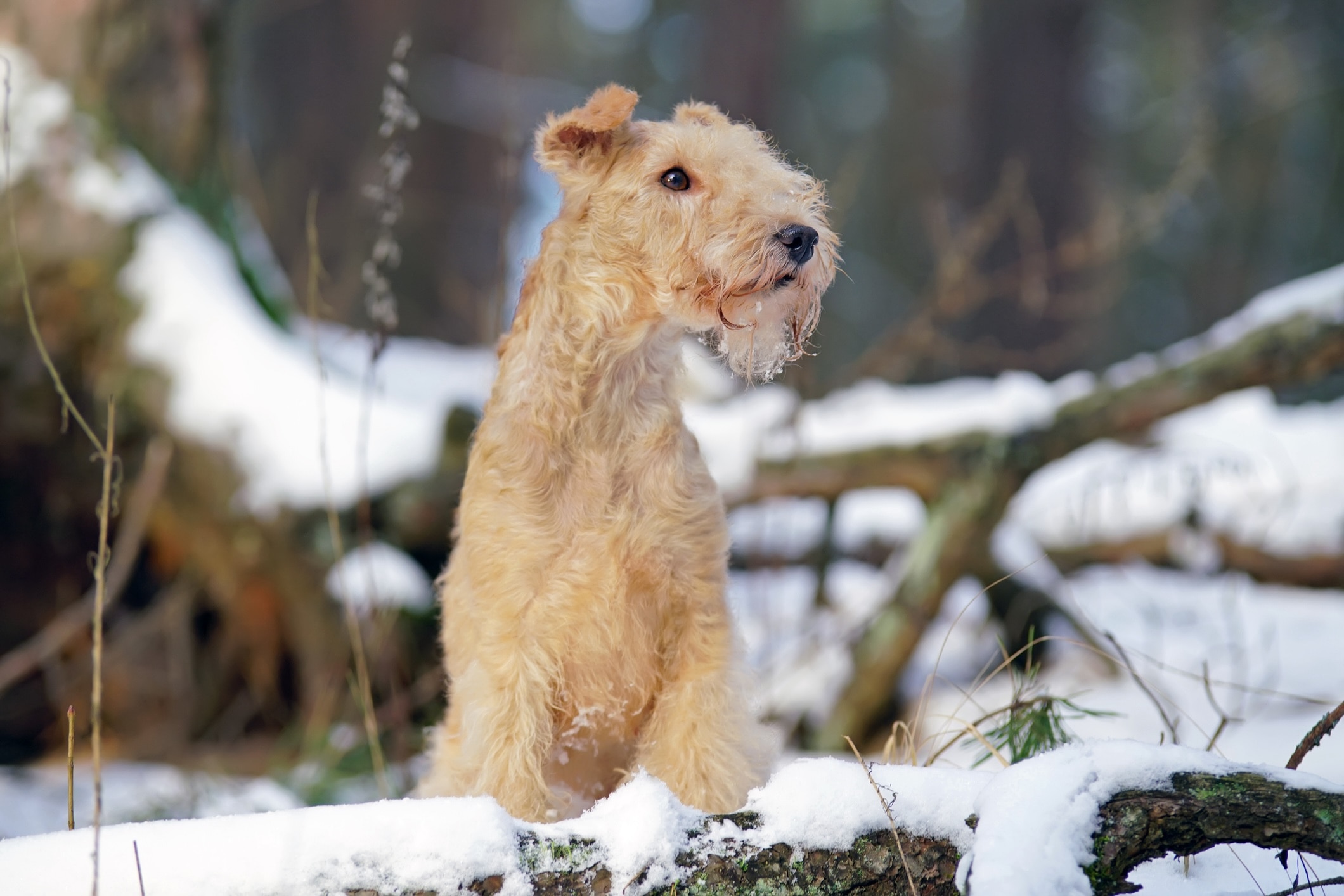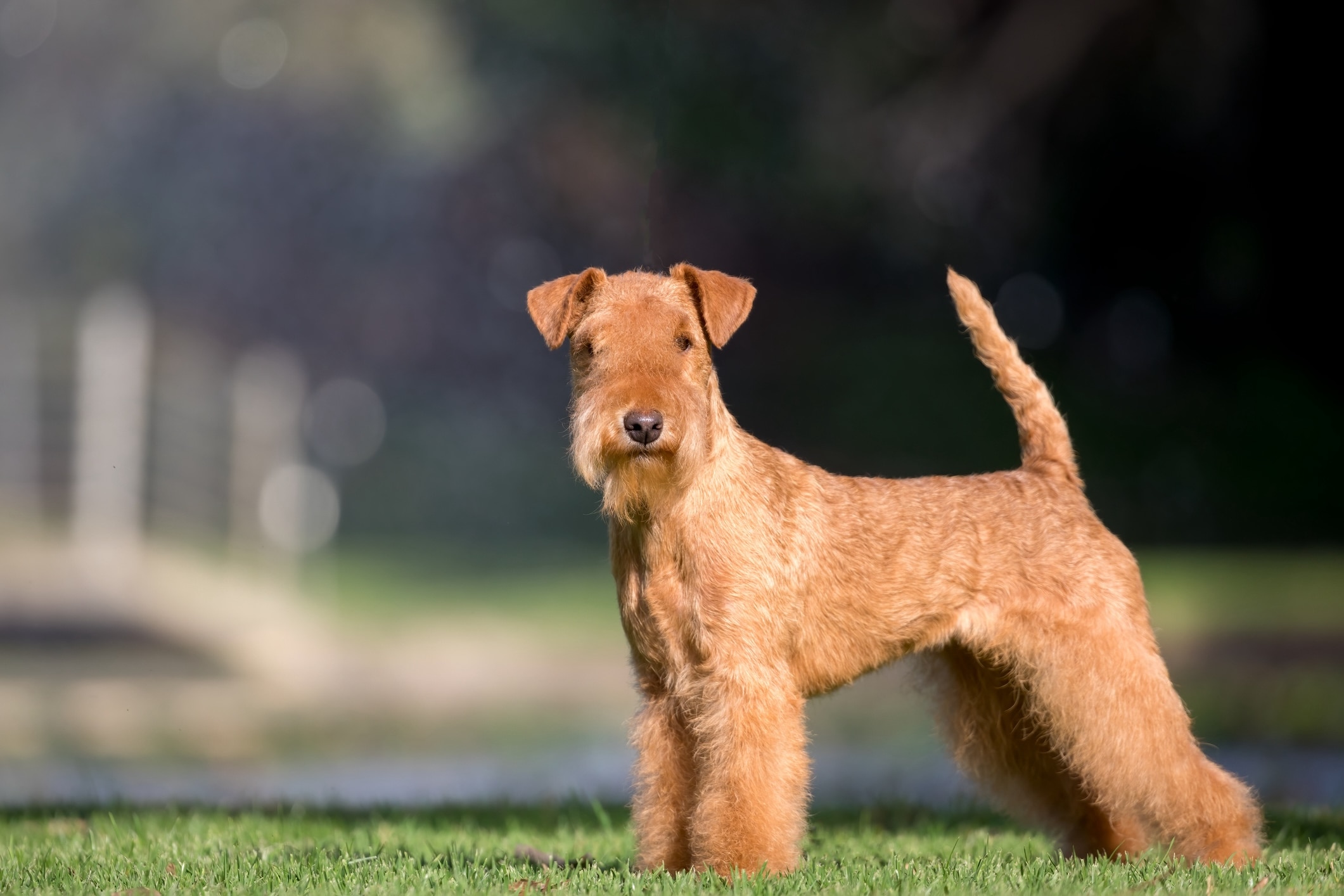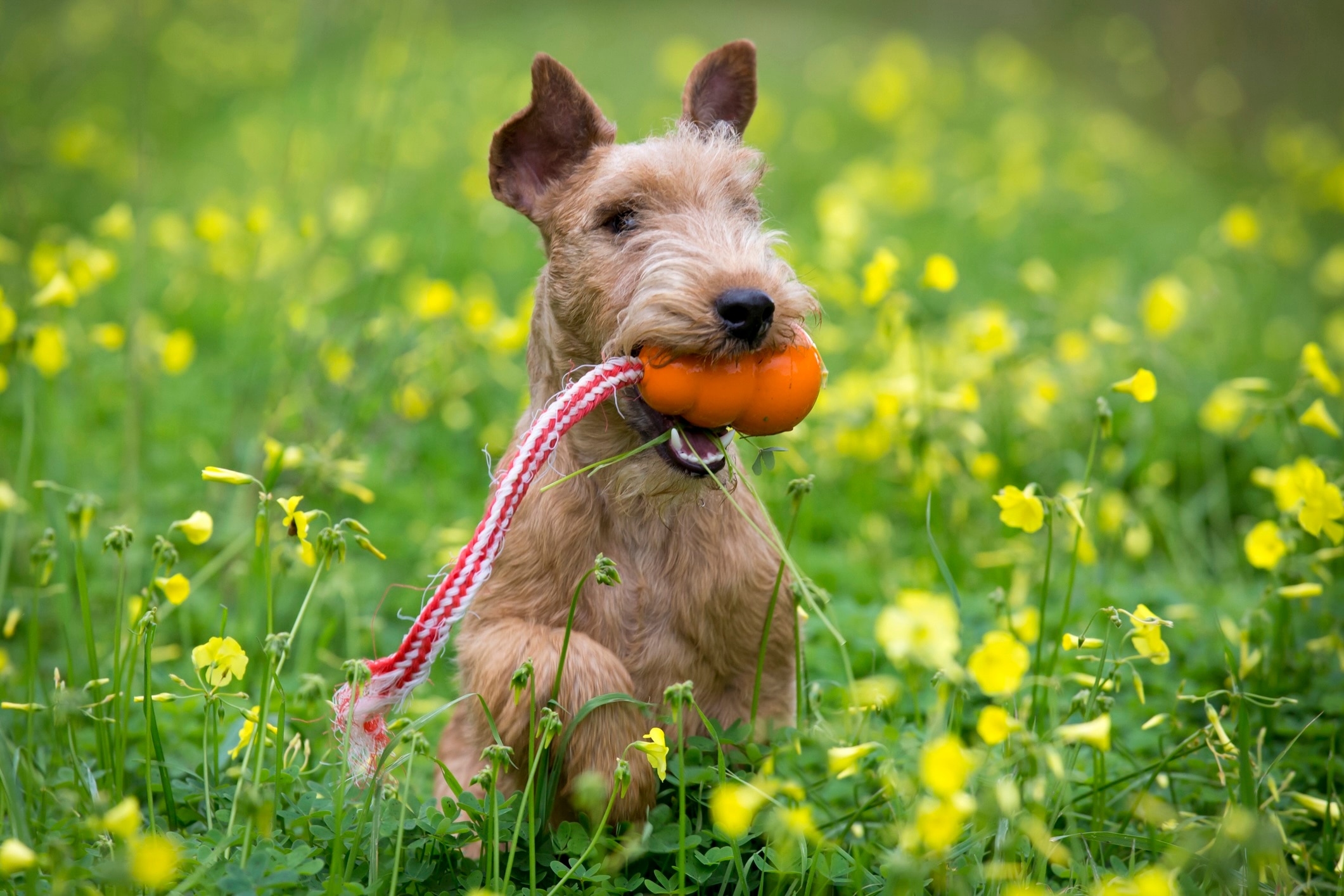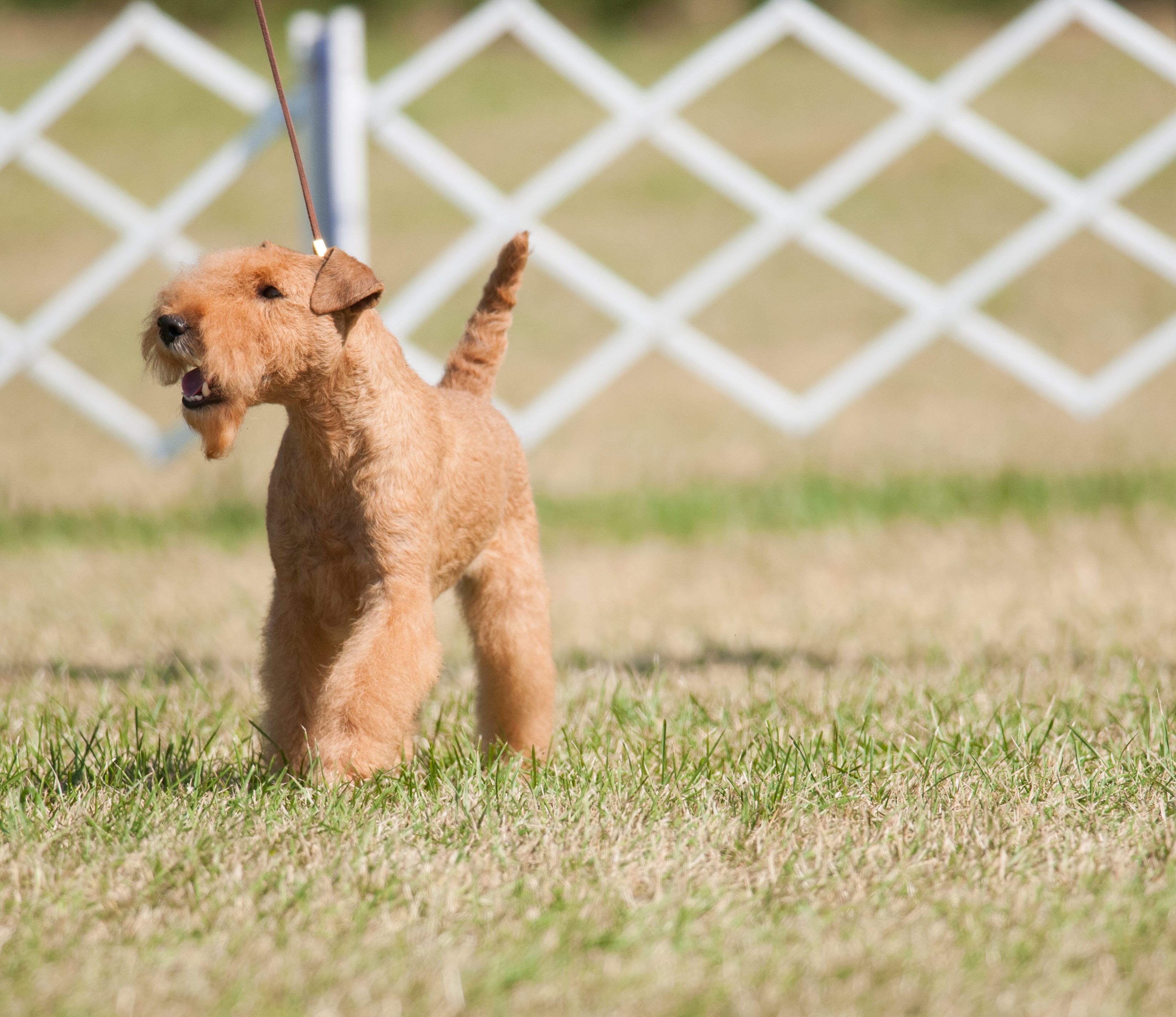Lakeland Terrier
Adobe Stock/ivkate
Hailing from the Lake District of northwest England, the Lakeland Terrier dog is an active and affectionate family pet.
Originally bred as a fox hunter, Lakelands were not carried on horseback during the hunt like the Wire Fox Terrier. Instead, they were expected to keep up with the hounds and hunt over rocky terrain on their own four feet. This resulted in a sturdy, small dog with a lot of stamina.
Lakeland Terriers have a loving personality and often do well as family dogs—as long as their energy and intellectual needs are met.
Caring for a Lakeland Terrier
As one of the smaller terrier breeds (Lakelands weigh 17 pounds or less and stand 14–15 inches tall), Lakeland Terriers are equally at home in the country or the city. As with other members of the terrier class, the dogs are smart and quick to learn, but they need early socialization to maximize their generally outgoing personality.
These dogs have moderate exercise needs—at least an hour of activity per day—and love to have a job or puzzle to work on. It’s best to keep them engaged and monitored in the back yard to avoid holes dug in the garden or escape attempts under the fence.
Lakeland Terrier dogs have a wired double coat that sheds minimally and doesn’t produce much dander. Routine coat stripping and clipping is necessary to maintain the “wired” appearance, but other grooming maintenance is minimal.
Lakeland Terrier Health Issues

The Lakeland Terrier is a healthy dog breed that generally lives 12–15 years. However, the dogs can be susceptible to some health conditions that are common in small-breed dogs.
Dental Disease
Lakeland Terriers, like many small dogs, are more prone to tartar accumulation than larger breeds, which leads to dental disease. Keeping your terrier’s teeth clean is important to prevent painful tooth root abscesses, as well as loss of teeth and jawbone density. Severe dental disease can even affect kidney and heart health.
Training your puppy to accept daily tooth brushing can help prevent tartar from building up, though many terriers require yearly anesthetic dental cleanings. Your veterinarian will monitor your dog’s oral health at their yearly physical exam and help you determine when a dental cleaning is needed.
Patella Luxation
Patella luxation is a disease where the kneecap no longer sits properly in the joint and moves (luxates) to the side. This can result in lameness or a hopping, three-legged gait.
X-rays can help diagnose your Lakeland Terrier with patella Luxation. Many cases can be managed with joint supplements and weight management. Severe cases can lead to painful ligament damage or an inability to walk properly and may require surgery.
What To Feed a Lakeland Terrier

Lakeland Terriers have no special breed-specific dietary needs. Like all dogs, they need a well-balanced commercial diet that meets the nutritional standards set by the Association of American Feed Control Officials (AAFCO).
Because the Lakeland Terrier dog breed is small, consider choosing a food with kibble sizes for small- breed dogs. Your veterinarian can help you choose the best dog food for your dog.
How To Feed a Lakeland Terrier
Lakeland Terrier puppies benefit from frequent small meals (four or five per day) to avoid low blood sugar, which can be seen in small-breed puppies.
For adult Lakeland Terriers, two or three meals a day should be more than enough to keep them satisfied and healthy. Puzzle feeders and lick mats are great ways to feed one or more of your terrier’s meals to give their hard-working brains a challenge.
How Much Should You Feed a Lakeland Terrier?
It is important to feed your dog measured (or even weighed!) meals according to a specific calorie goal to avoid obesity, which can lead to many health issues. Using the nutrition label of your food of choice as a guideline, work with your veterinarian to ensure your pup’s nutritional needs are met.
Don’t forget that dental treats and other rewards have calories, too. Treats can add up quickly in small-breed dogs like Lakeland Terriers, but they should never make up more than 10% of your dog’s daily calories.
Nutritional Tips for Lakeland Terriers
Healthy Lakeland Terriers shouldn’t need nutritional supplements as long as they are fed a balanced commercial diet that meets AAFCO standards. Do not give your dog supplements without talking to your vet first.
Behavior and Training Tips for Lakeland Terriers
Lakeland Terrier Personality and Temperament

Lakelands are generally considered excellent family dogs—especially if they are kept busy. These intelligent pups are eager to please, and always up for an adventure or game.
Lakeland Terrier dogs may be wary of strangers, but their temperament leaves them eager to adopt new people into their family circle once they get to know them.
Like all terriers, they do best with older, responsible children. Interactions between dogs and children should always be supervised. They can get along well with other dogs, but be cautious when introducing them to cats or other small animals, as they still have a prey drive from their fox-hunting days.
Lakeland Terrier Behavior
Bred to chase and burrow after foxes, Lakeland Terrier dogs tend to dig holes in gardens and under fences when left to their own devices. Active play will help keep them out of trouble, and leaving them unattended in the yard is not recommended.
Lakelands vocalize frequently to alert their pet parents to changes in the environment, and their high-pitched bark may not be appreciated in an apartment setting. Training can help curb this behavior, but it won’t eliminate it. So, be prepared for lots of barking from your pup.
Lakeland Terrier Training
Lakeland Terriers are smart and learn cues quickly, but they might have their own ideas about how consistent they have to be when following rules. Starting training early using positive reinforcement; being consistent in your asks will go a long way in keeping your Lakeland Terrier on their best behavior.
Lakelands have a reputation for getting bored easily, so having some variety in training sessions and offering rewards will help keep them happy and engaged. Early socialization and puppy classes are extremely important to help keep your Lakeland Terrier dog as friendly with new people and dogs as they are with their family.
Fun Activities for Lakeland Terriers
Lakeland Terrier Grooming Guide

Lakeland Terriers don’t shed much and are sometimes considered hypoallergenic dogs. But no dog is completely hypoallergenic, as allergens are found in their urine, skin, and saliva—not just fur. That said, the Lakeland Terrier dog breed may be a good fit for certain people with allergies.
Lakelands kept as companion dogs should be brushed regularly to keep their wired coat from tangling, and they should be bathed when dirty. Show dogs require hand-stripping—a process wherein the fur is removed at the root instead of cut—to remove dead hairs and maintain the coarser breed-standard coat, but this is not required for health.
Skin Care
Lakeland Terriers should be bathed with a dog shampoo at least once monthly to keep their skin free of dirt and debris.
Coat Care
A Lakeland’s wire coat should be brushed weekly to avoid matting.
The dogs should also be clipped or hand-stripped two or three times a year to keep excess dead hairs from building up. Both grooming methods result in a healthy coat, though clippers will lead to a softer, bushier appearance than hand-stripping.
Eye Care
Lakeland Terriers do not require special care for their eyes. If you notice changes in your dog’s eyes, including discharge or redness, talk to your vet.
Ear Care
The Lakeland Terrier’s upright, triangular ears don’t usually need special care. That said, ear infections are still possible. Discuss routine ear cleaning with your veterinarian if you have concerns about your dog’s ear health.
Considerations for Pet Parents
The Lakeland Terrier is an excellent choice for a family interested in an engaged, active companion. With few health considerations and a relatively low-maintenance coat, Lakelands offer big personalities in a small package.
Early training and socialization are essential to perfecting your relationship with this independent dog. Well-socialized Lakelands do extremely well with older children and other dogs. Activities like agility, obedience training, and exploring new neighborhoods on leash will keep you both from getting bored.
Routine preventatives, vaccinations, and good at-home care will keep your Lakeland healthy well into their teen years.
Lakeland Terrier FAQs
Is a Lakeland Terrier a good family dog?
Yes, Lakeland Terriers are considered excellent family dogs as long as they are socialized, exercised, and given clear expectations. They bond well with multiple people and thrive with a busy, active environment.
Are Lakeland Terriers cuddly?
Lakeland Terriers are affectionate but independent. While they may spend time on the couch and love their human companions, they thrive on interactive play and satisfying their curiosity in a fenced yard.
Are Lakeland Terriers hyper?
Lakeland Terriers are an active but polite breed, especially when properly trained. They are vocal and will bark to communicate, but if given appropriate exercise and interaction, they are generally calm and well behaved.
What’s the difference between a Lakeland Terrier and an Airedale Terrier?
Though the breeds are likely distantly related and look similar, Lakeland Terriers are much smaller than Airedale Terriers, which average 50–70 pounds.
